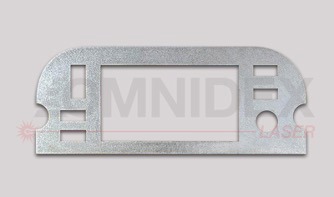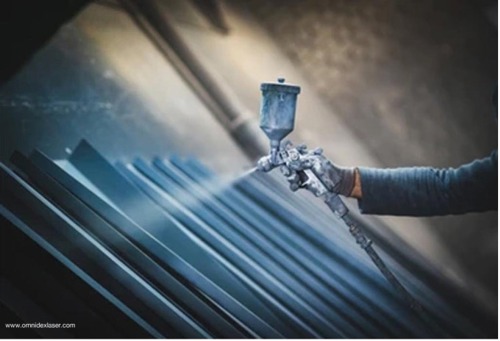Some form of finishing process will be required if you want to produce ready-for-market laser cut parts or just want your parts to be consistently finished. Whether you’re repairing an old scratch or adding a colourful luster to a dull, metallic piece, there’s the right finish for every application.
Our company provides a variety of finishing processes, and we will discuss the options we can undertake, as well as how you can create your own.
This article provides some background on the deburring, coating, and tumbling services which we can provide. Additional and common finishing options can also be undertaken.
Contact laser@omnidexgroup.com for help choosing the right process for your project.
In-house finishing processes at Omnidex
Let’s have a look at the finishing processes we offer at Omnidex.
Tumbling and deburring of ceramics are completely free of charge. If you want to laser cut the deburred edges of your file, just select “deburring” when you upload it. However, please remember that even though deburring and tumbling are good options for smoothing out sharp edges, they will not make your part look perfect. It’s likely that some minor finishing work will be required to make them shine.


1. Deburring
Deburring is the most common finishing process. In addition to removing scratches and burrs from the surface, deburring can also remove minor imperfections. Simple and effective, it prepares your parts for subsequent painting or anodizing. However, the surface of parts will not be perfectly smooth after deburring.
Generally, we use our deburring service for larger parts, with a shortest axis of no more than 24″ . On one side of deburred parts, scratches and dross are brushed to smooth them, so there may still be scratches on the bottom face of your part. For more information, please refer to our full guidelines.
2. Tumbling
Ceramic tumbling processes are an Omnidex speciality. Due to our harmonically tuned equipment, we are able to tumble more material in a vibratory-abrasive manner than we are able to tumble in a traditional manner. This allows us to provide your parts with a much higher level of consistency using a rock tumbler.

Tumbling is used for laser cut parts that are very small. Our tumbling process can deburr pieces as small as 1 square inch, much smaller than most deburring processes. Even though tumbling will smooth out the rough edges, it won’t give parts a “finished” appearance. One of the processes we discuss later in this article will be required for a truly finished product, since they may still have scratches or marks from the manufacturing process.
3. Powder coating
Powder coating is one of our favourite processes at Omnidex.
In contrast to the wet application of paint, powder coating is applied electrostatically after starting off-dry. A curing oven is then used to finish the coat. It is possible to powder coat any material which can hold an electrostatic charge. Aluminium, steel, stainless steel, and other metals can all be powder coated.
Powder coat is available in the following colours : black (matte, gloss, and wrinkle), red, white, and yellow. The minimum order for powder coated parts is 20 parts per the desired colour. Our powder coating service is simple and easy. Upload your design, select the colour(s) you want to powder coat, and then we’ll do the rest. Be sure to review our powder coating design guidelines.
More Finishing Options
i. Brushing
Sheet metal can be brushed to create a really nice, rustic finish. Stainless steel works especially well for this. Manufacturers can easily do this finishing process themselves. The sanding belt or drum, 120-180 grit sandpaper, and WD-40 are all you need for this process. Coat the metal thinly with lubricant, then slowly sand in a single direction with a sanding belt and sandpaper.

The most important thing to remember when brushing sheet metal is that if you move the sandpaper around too much, it will mark the metal, so make sure you apply constant pressure and only move the belt in one direction. In order to achieve a swirled pattern on the surface, you need to move the sanding belt in a concentric motion.
You should wipe down the dust left behind after the sanding is completed with a grease-cutting agent. Several passes with the sanding belt may be necessary to get the final look right, but there’s nothing wrong with putting in a little extra elbow grease.
ii. Media Blasting
Media blasting involves shooting abrasive material at a surface under high pressure to shape, smooth, clean, or roughen the surface, based on the abrasive and method used. Blasting is typically done in conjunction with pressure washing and is typically used to prepare surfaces for painting and other finishes. Wet blasting is often used in conjunction with pressure washing.
There are many different abrasives used in blasting sheet metal, including walnut shells, metal shot, glass beads, and even dry ice. Sand is one of the more common abrasives used, so blasting is commonly referred to simply as “sandblasting.” Blasting can accommodate larger surfaces and parts than tumbling.
Blasting can be a hazardous and difficult process, so finding a local professional may be advisable, but it is common and there are typically many local companies that offer blasting services.
iii. Painting
It is essential the metal piece is properly prepared before painting laser cut parts. The best way to prepare your components if they are not being blasted is to brush them with an abrasive material and then wash them in acetone (diluted if necessary). In addition to tackling any dirt or residue that may interfere with a smooth finish, this step will also create a rough surface for the paint to adhere to.
Old-fashioned techniques are sometimes the most effective.


iv. Anodizing
Anodizing involves charging a liquid bath with electrical current in which to immerse metal, usually aluminium or titanium. Through this reaction, the metal’s oxide outer layer thickens, giving it a durable and scratch-resistant finish. Most commonly sulfuric acid is employed in the charged liquid bath, but chromatic acid is sometimes used as well. When anodizing your parts, you can choose between clear or dyed finishes.
In terms of aesthetics, anodizing is hard to beat. In addition to giving the metal a corrosion-resistant finish, it also makes it heat and electrically resistant, making it a great option for parts exposed to electricity or the elements.
Omnidex Laser offers custom sheet metal services
We have only scratched the surface of the finishing iceberg. A lot of different plating processes are also available, such as blackening, chemical etching, dip coating, etc. We have given only a brief introduction to each process. If you are interested in one of them, our expertise covers several of these areas, so we are happy to help you decide how to complete your project.
We can be reached via email at laser@omnidexgroup.com, or if you already have a part in mind, we can provide a custom quote and answer your questions.
Let’s make your parts look as fantastic as you envisioned. Request a quote today!









Water Sector Talent Exodus Could Cripple The Sector
Maybe if things are essential for the running of a country and we want to pay a fair price we should be running these utilities on a not for profit...